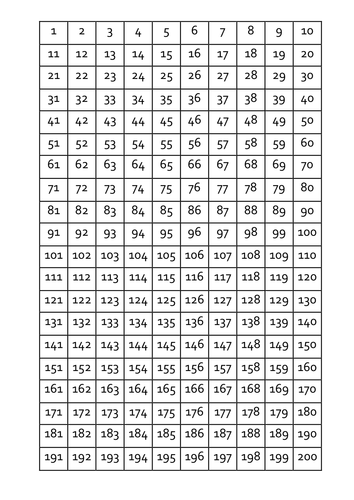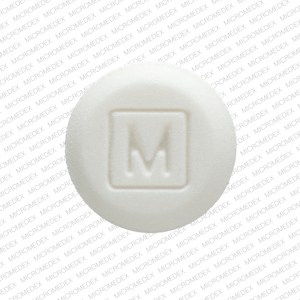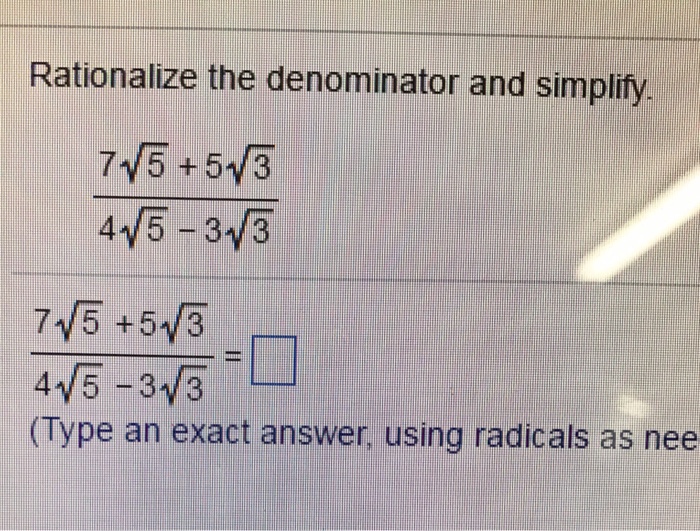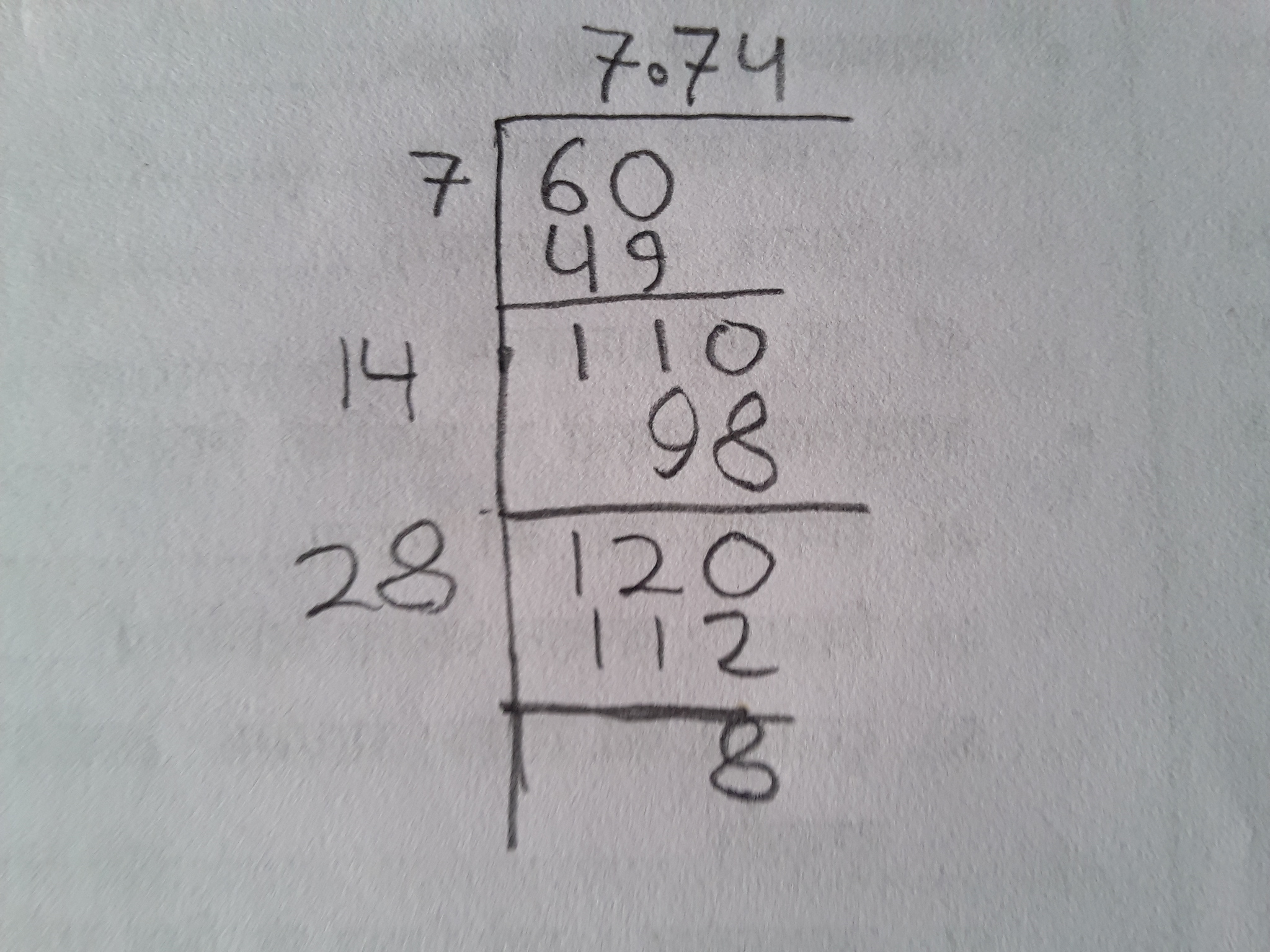Topic square roots from 1 to 20: Explore the world of square roots from 1 to 20 with our comprehensive guide. Learn calculation methods, understand applications in mathematics, and discover practical examples to deepen your understanding. Whether you're a student or enthusiast, this article provides valuable insights into the fundamental concepts and uses of square roots.
Table of Content
- Square Roots from 1 to 20
- Introduction to Square Roots
- Understanding the Basics
- Calculation Methods and Techniques
- Common Square Roots Table
- Applications of Square Roots in Mathematics
- Visualizing Square Roots
- Advanced Topics in Square Roots
- Exploring Special Cases
- Practical Examples and Exercises
- Conclusion and Further Reading
- YOUTUBE:
Square Roots from 1 to 20
The square root of a number is a value that, when multiplied by itself, gives the original number. Here are the square roots of the numbers from 1 to 20.
Table of Square Roots from 1 to 20
| Number | Square Root |
|---|---|
| 1 | \(\sqrt{1} = 1\) |
| 2 | \(\sqrt{2} \approx 1.414\) |
| 3 | \(\sqrt{3} \approx 1.732\) |
| 4 | \(\sqrt{4} = 2\) |
| 5 | \(\sqrt{5} \approx 2.236\) |
| 6 | \(\sqrt{6} \approx 2.449\) |
| 7 | \(\sqrt{7} \approx 2.646\) |
| 8 | \(\sqrt{8} \approx 2.828\) |
| 9 | \(\sqrt{9} = 3\) |
| 10 | \(\sqrt{10} \approx 3.162\) |
| 11 | \(\sqrt{11} \approx 3.317\) |
| 12 | \(\sqrt{12} \approx 3.464\) |
| 13 | \(\sqrt{13} \approx 3.606\) |
| 14 | \(\sqrt{14} \approx 3.742\) |
| 15 | \(\sqrt{15} \approx 3.873\) |
| 16 | \(\sqrt{16} = 4\) |
| 17 | \(\sqrt{17} \approx 4.123\) |
| 18 | \(\sqrt{18} \approx 4.243\) |
| 19 | \(\sqrt{19} \approx 4.359\) |
| 20 | \(\sqrt{20} \approx 4.472\) |
Key Concepts
- Perfect Squares: Numbers like 1, 4, 9, and 16 are perfect squares and their square roots are integers.
- Non-Perfect Squares: Numbers like 2, 3, 5, and 6 are not perfect squares and their square roots are irrational numbers.
Applications
Square roots are used in various fields such as geometry, physics, and engineering to solve equations and calculate distances, areas, and volumes. Understanding square roots is fundamental in algebra and higher-level mathematics.
Examples
- To find the length of a side of a square with an area of 11 sq. inches, we calculate \(\sqrt{11} \approx 3.317\) inches.
- For a circular tabletop with an area of \(15\pi\) sq. inches, the radius is \(\sqrt{15} \approx 3.873\) inches.
Practice Problems
- What is the square root of 12? (Answer: \(\sqrt{12} \approx 3.464\))
- Find the square root of 19. (Answer: \(\sqrt{19} \approx 4.359\))

READ MORE:
Introduction to Square Roots
Square roots are fundamental mathematical operations that involve finding a number which, when multiplied by itself, gives a specified number. For numbers from 1 to 20, understanding square roots provides insights into basic arithmetic and more advanced mathematical concepts.
In mathematical notation, the square root of a number \( x \) is denoted as \( \sqrt{x} \). For example:
- The square root of 1 (\( \sqrt{1} \)) is 1.
- The square root of 4 (\( \sqrt{4} \)) is 2.
- The square root of 9 (\( \sqrt{9} \)) is 3.
- And so on, up to 20.
Understanding square roots is crucial in various fields, including geometry, physics, engineering, and computer science. It forms the basis for quadratic equations, Pythagorean theorem applications, and calculations involving areas and volumes.
Understanding the Basics
Square roots are mathematical expressions that represent a value which, when multiplied by itself, gives the original number. For example, the square root of 16 is 4, because 4 × 4 = 16. The symbol for the square root is √, and the square root of a number x is written as √x.
Here are some fundamental concepts to understand square roots:
- Perfect Squares: Numbers like 1, 4, 9, 16, and so on are called perfect squares because they are the squares of whole numbers (1, 2, 3, 4, etc.).
- Non-Perfect Squares: Numbers that are not perfect squares do not have whole numbers as their square roots. For example, √2 and √3 are irrational numbers.
- Positive and Negative Roots: Every positive number has two square roots: one positive and one negative. For example, both 4 and -4 are square roots of 16. However, when we refer to "the square root," we typically mean the positive root.
To better understand square roots, consider the following table of square roots from 1 to 20:
| Number | Square Root |
|---|---|
| 1 | 1 |
| 2 | 1.414 |
| 3 | 1.732 |
| 4 | 2 |
| 5 | 2.236 |
| 6 | 2.449 |
| 7 | 2.646 |
| 8 | 2.828 |
| 9 | 3 |
| 10 | 3.162 |
| 11 | 3.317 |
| 12 | 3.464 |
| 13 | 3.606 |
| 14 | 3.742 |
| 15 | 3.873 |
| 16 | 4 |
| 17 | 4.123 |
| 18 | 4.243 |
| 19 | 4.359 |
| 20 | 4.472 |
In summary, understanding the basics of square roots involves recognizing the difference between perfect and non-perfect squares, knowing the notation, and familiarizing yourself with the square roots of numbers from 1 to 20. This foundational knowledge is crucial for more advanced topics in mathematics.
Calculation Methods and Techniques
Calculating the square root of a number involves several methods and techniques. Here, we explore some of the most commonly used methods:
1. Prime Factorization Method
The prime factorization method involves expressing the number as a product of its prime factors and then simplifying.
- Factorize the number into its prime factors.
- Pair the prime factors.
- Take one factor from each pair and multiply them to get the square root.
Example: Find the square root of 144.
Prime factorization: \(144 = 2^4 \times 3^2\)
Pair the factors: \( (2^2) \times (2^2) \times (3^2)\)
Take one from each pair: \(2 \times 2 \times 3 = 12\)
So, \(\sqrt{144} = 12\)
2. Long Division Method
The long division method is a systematic process used for finding more accurate square roots, especially for non-perfect squares.
- Separate the digits into pairs, starting from the decimal point.
- Find the largest number whose square is less than or equal to the first pair.
- Subtract the square from the first pair and bring down the next pair.
- Double the divisor and determine the next digit.
- Repeat the steps until you reach the desired accuracy.
Example: Find the square root of 20.
Steps:
- Pair the digits: 20.
- Find the largest number: 4 (since \(4^2 = 16\)).
- Subtract and bring down: \(20 - 16 = 4\).
- Double the divisor (4 becomes 8) and find the next digit.
- Continue the process to get more decimal places.
3. Estimation Method
The estimation method is useful for quickly approximating the square root of a number.
- Find the nearest perfect squares between which the number lies.
- Estimate the square root by averaging the values.
Example: Estimate the square root of 50.
Nearest perfect squares: \(49 (7^2)\) and \(64 (8^2)\).
Since 50 is closer to 49, the square root is approximately 7.1.
4. Using Mathematical Tables
Mathematical tables, such as those listing square roots of numbers from 1 to 100, can be used for quick reference.
Example: From the table, \(\sqrt{50} \approx 7.071\).
5. Using Calculators
Modern calculators have a square root function that allows for quick and accurate calculation.
Simply input the number and press the square root button to obtain the result.
6. Repeated Subtraction Method
This method is more theoretical and involves repeatedly subtracting odd numbers from the given number until you reach zero.
- Start with the number and subtract successive odd numbers.
- Count the number of subtractions.
Example: Find the square root of 16.
Steps: 16 - 1 = 15, 15 - 3 = 12, 12 - 5 = 7, 7 - 7 = 0.
Number of subtractions: 4, so \(\sqrt{16} = 4\).
7. Visual Method
This involves plotting the number on a graph and using geometric methods to find the square root.
Example: Using a number line or a coordinate system to visualize and calculate the square root geometrically.
These methods provide a variety of ways to calculate square roots, each useful in different contexts and for different levels of precision.
Common Square Roots Table
Understanding the square roots of numbers from 1 to 20 is essential for many mathematical calculations and applications. Below is a comprehensive table listing the square roots of numbers from 1 to 20.
| Number | Square Root (√) |
|---|---|
| 1 | 1.000 |
| 2 | 1.414 |
| 3 | 1.732 |
| 4 | 2.000 |
| 5 | 2.236 |
| 6 | 2.449 |
| 7 | 2.646 |
| 8 | 2.828 |
| 9 | 3.000 |
| 10 | 3.162 |
| 11 | 3.317 |
| 12 | 3.464 |
| 13 | 3.606 |
| 14 | 3.742 |
| 15 | 3.873 |
| 16 | 4.000 |
| 17 | 4.123 |
| 18 | 4.243 |
| 19 | 4.359 |
| 20 | 4.472 |
Memorizing or having quick access to this table can greatly aid in solving mathematical problems more efficiently. These square roots are commonly used in various mathematical calculations, including solving quadratic equations, geometry, and real-world applications such as physics and engineering.

Applications of Square Roots in Mathematics
Square roots have numerous applications in various fields of mathematics and real-life scenarios. Here are some common uses:
- Pythagorean Theorem: In geometry, square roots are used to find the length of a side in a right-angled triangle. For a right triangle with sides \(a\), \(b\), and hypotenuse \(c\), the relationship is: \[ c = \sqrt{a^2 + b^2} \]
- Quadratic Equations: Square roots are essential in solving quadratic equations using the quadratic formula: \[ x = \frac{{-b \pm \sqrt{b^2 - 4ac}}}{2a} \] This formula helps find the roots of equations of the form \(ax^2 + bx + c = 0\).
- Distance Formula: In coordinate geometry, the distance between two points \((x_1, y_1)\) and \((x_2, y_2)\) is calculated using: \[ d = \sqrt{(x_2 - x_1)^2 + (y_2 - y_1)^2} \] This formula is derived from the Pythagorean Theorem.
- Area and Perimeter: To find the side length of a square given its area \(A\): \[ \text{Side length} = \sqrt{A} \] For example, if the area is 25 square units, the side length is \(\sqrt{25} = 5\) units.
- Physics - Free Fall: The time \(t\) it takes for an object to fall from a height \(h\) under gravity can be approximated using: \[ t = \frac{\sqrt{h}}{4} \] For instance, if an object is dropped from a height of 64 feet, the time to hit the ground is \(\frac{\sqrt{64}}{4} = 2\) seconds.
- Accident Investigation: In forensic science, the speed \(s\) of a vehicle before braking can be estimated from the length \(d\) of its skid marks: \[ s = \sqrt{24d} \] If skid marks are 190 feet long, the speed is \(\sqrt{24 \times 190} \approx 67.5\) mph.
Understanding these applications highlights the importance of square roots in both theoretical and practical contexts, aiding in solving problems across different fields.
Visualizing Square Roots
Visualizing square roots helps in understanding their properties and the relationships between perfect squares and non-square numbers. Below are some methods to visualize square roots effectively:
Using Grid Paper
One way to visualize square roots is by using grid paper. Here's a step-by-step method:
- Draw a square for a perfect square number. For example, to visualize √16, draw a 4x4 square since 42 = 16.
- For non-square numbers like 17, start with the nearest lower perfect square (16 in this case). Draw the 4x4 square and then add one more unit to visualize the extra area.
- Estimate the side length of the new shape. This helps to approximate the square root. For √17, it's slightly more than 4.
Using Manipulatives
Manipulatives like algebra tiles can also help in visualizing square roots:
- Arrange the tiles to form a square for perfect squares.
- For non-square numbers, add smaller tiles around the square to approximate the square root. For instance, approximating √19 involves adding extra tiles around the 4x4 square for 16.
- This method visually demonstrates how the square root of non-square numbers is slightly more than the nearest perfect square root.
Graphical Representation
Graphical tools such as Geogebra can be used to visualize square roots. Follow these steps:
- Plot the perfect squares on a graph. For example, plot points (1,1), (2,4), (3,9), etc.
- For non-square numbers, locate the position between the nearest perfect squares. For example, √5 is between 2 (√4) and 3 (√9).
- This visual placement helps in understanding the value of square roots between integers.
Using Pythagoras' Theorem
Pythagoras' Theorem is another way to visualize square roots:
- Consider a right triangle with legs of length 1 and the hypotenuse will be √2.
- For √5, create a right triangle where one leg is 2 (√4) and the other leg is 1. The hypotenuse will give the √5.
Interactive Tools
Interactive tools and digital resources can enhance the understanding of square roots:
- Use online graphing calculators to plot and visualize square roots dynamically.
- Interactive simulations can help explore the concept of square roots and their properties more deeply.
By employing these visual methods, learners can develop a more intuitive understanding of square roots, making the concept clearer and more concrete.
Advanced Topics in Square Roots
Square roots extend beyond basic calculations and have advanced applications and properties in mathematics. In this section, we explore some of these advanced topics.
1. Simplifying Radical Expressions
Simplifying radical expressions involves reducing the expression to its simplest form. For example:
- \(\sqrt{50}\) can be simplified to \(5\sqrt{2}\) because \(50 = 25 \times 2\) and \(\sqrt{25} = 5\).
- \(\sqrt{72}\) can be simplified to \(6\sqrt{2}\) because \(72 = 36 \times 2\) and \(\sqrt{36} = 6\).
2. Rationalizing the Denominator
Rationalizing the denominator involves removing the radical from the denominator of a fraction. For example:
- \(\frac{1}{\sqrt{2}}\) is rationalized to \(\frac{\sqrt{2}}{2}\).
- \(\frac{3}{\sqrt{5}}\) is rationalized to \(\frac{3\sqrt{5}}{5}\).
3. Complex Numbers and Square Roots
Square roots of negative numbers lead to complex numbers. The square root of \(-1\) is represented by \(i\), where \(i^2 = -1\). For example:
- \(\sqrt{-4} = 2i\).
- \(\sqrt{-9} = 3i\).
4. Properties of Square Roots
Square roots have several important properties that are useful in various mathematical contexts:
- \(\sqrt{ab} = \sqrt{a} \times \sqrt{b}\).
- \(\sqrt{\frac{a}{b}} = \frac{\sqrt{a}}{\sqrt{b}}\).
- \((\sqrt{a})^2 = a\).
5. Applications in Calculus
Square roots are used in calculus, particularly in solving integrals and derivatives. For example:
- The derivative of \( \sqrt{x} \) is \( \frac{1}{2\sqrt{x}} \).
- The integral of \( \sqrt{x} \) is \( \frac{2}{3}x^{3/2} + C \).
6. Elliptic Curves
Square roots play a crucial role in the study of elliptic curves, which are used in number theory and cryptography. An elliptic curve is defined by an equation of the form:
\(y^2 = x^3 + ax + b\)
where \(a\) and \(b\) are constants. Solutions to this equation are used in cryptographic algorithms.
7. Solving Quadratic Equations
Square roots are essential in solving quadratic equations of the form \(ax^2 + bx + c = 0\). The solutions are given by the quadratic formula:
\(x = \frac{-b \pm \sqrt{b^2 - 4ac}}{2a}\)
8. Pythagorean Theorem
The Pythagorean theorem, which relates the sides of a right triangle, often requires the use of square roots. The theorem states:
\(a^2 + b^2 = c^2\)
where \(c\) is the hypotenuse. To find \(c\), we use:
\(c = \sqrt{a^2 + b^2}\)
Exploring Special Cases
Square roots have some interesting special cases and properties that are important to understand. Here, we will explore a few of these special cases.
Square Roots of Perfect Squares
A perfect square is a number that is the square of an integer. The square roots of perfect squares are always integers. For example:
- \(\sqrt{1} = 1\)
- \(\sqrt{4} = 2\)
- \(\sqrt{9} = 3\)
- \(\sqrt{16} = 4\)
- \(\sqrt{25} = 5\)
- \(\sqrt{36} = 6\)
- \(\sqrt{49} = 7\)
- \(\sqrt{64} = 8\)
- \(\sqrt{81} = 9\)
- \(\sqrt{100} = 10\)
Non-Perfect Squares
Numbers that are not perfect squares have irrational square roots, meaning they cannot be expressed as a simple fraction and their decimal form goes on forever without repeating. For instance:
- \(\sqrt{2} \approx 1.414\)
- \(\sqrt{3} \approx 1.732\)
- \(\sqrt{5} \approx 2.236\)
- \(\sqrt{10} \approx 3.162\)
Negative Numbers and Imaginary Numbers
The square root of a negative number is not a real number. Instead, it is an imaginary number. Imaginary numbers are based on the imaginary unit \(i\), where \(i = \sqrt{-1}\). For example:
- \(\sqrt{-1} = i\)
- \(\sqrt{-4} = 2i\)
- \(\sqrt{-9} = 3i\)
Properties of Square Roots
- Product Property: \(\sqrt{a \cdot b} = \sqrt{a} \cdot \sqrt{b}\)
- Quotient Property: \(\sqrt{\frac{a}{b}} = \frac{\sqrt{a}}{\sqrt{b}}\)
- Addition and Subtraction: You cannot generally simplify the addition or subtraction of square roots, e.g., \(\sqrt{a} + \sqrt{b} \neq \sqrt{a + b}\).
Examples of Simplifying Square Roots
To simplify square roots, factor out the largest perfect square factor:
- \(\sqrt{50} = \sqrt{25 \cdot 2} = \sqrt{25} \cdot \sqrt{2} = 5\sqrt{2}\)
- \(\sqrt{72} = \sqrt{36 \cdot 2} = \sqrt{36} \cdot \sqrt{2} = 6\sqrt{2}\)
Understanding these special cases and properties of square roots helps in various mathematical applications, including solving equations and simplifying expressions.
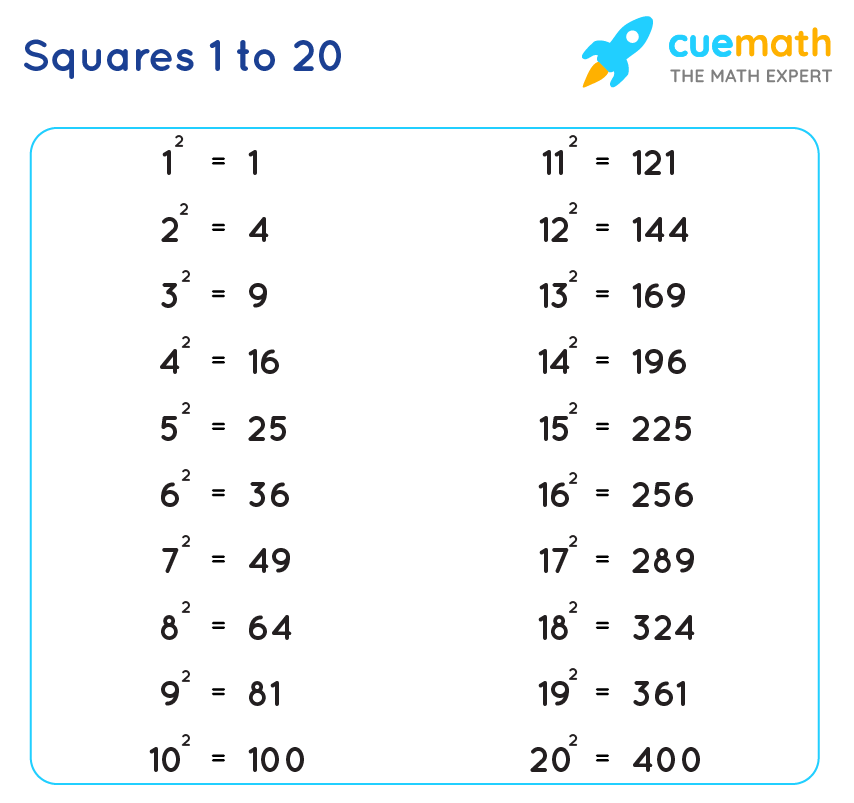
Practical Examples and Exercises
Understanding the practical applications of square roots can help solidify the concept and provide a clearer understanding of its uses in real-world situations. Below are a few examples and exercises to practice your knowledge of square roots from 1 to 20.
Example 1: Finding the Side of a Square
A square metal sheet has an area of 11 square inches. To find the length of one side of the square:
- Let the length of the side be \( a \).
- Given that the area of the square \( = a^2 \).
- \( a^2 = 11 \).
- Therefore, \( a = \sqrt{11} \approx 3.317 \) inches.
Example 2: Finding the Radius of a Circle
If a circular tabletop has an area of \( 15\pi \) square inches, find the radius:
- Let the radius be \( r \).
- Given that the area of the circle \( = \pi r^2 \).
- \( \pi r^2 = 15\pi \).
- Dividing both sides by \( \pi \), we get \( r^2 = 15 \).
- Therefore, \( r = \sqrt{15} \approx 3.873 \) inches.
Example 3: Adding Square Roots
Calculate \( 9\sqrt{15} + 6\sqrt{13} \):
- Find the approximate values of the square roots: \( \sqrt{15} \approx 3.873 \) and \( \sqrt{13} \approx 3.606 \).
- Multiply: \( 9 \times 3.873 = 34.857 \) and \( 6 \times 3.606 = 21.636 \).
- Add the results: \( 34.857 + 21.636 = 56.493 \).
Exercises
Practice the following exercises to improve your understanding:
- Find the side length of a square with an area of 20 square inches.
- If the radius of a circular garden is \( \sqrt{10} \) feet, what is its area?
- Simplify the expression \( 5\sqrt{8} + 3\sqrt{18} \).
- Determine the length of a diagonal of a rectangle with sides 6 inches and 8 inches using the Pythagorean theorem.
Solutions
- Exercise 1: \( \sqrt{20} \approx 4.472 \) inches.
- Exercise 2: Area \( = \pi (\sqrt{10})^2 = 10\pi \approx 31.416 \) square feet.
- Exercise 3: \( 5\sqrt{8} + 3\sqrt{18} = 5 \times 2.828 + 3 \times 4.243 \approx 14.14 + 12.729 = 26.869 \).
- Exercise 4: Diagonal \( = \sqrt{6^2 + 8^2} = \sqrt{36 + 64} = \sqrt{100} = 10 \) inches.
Conclusion and Further Reading
Understanding square roots is a fundamental part of mathematics with applications spanning from basic arithmetic to advanced scientific computations. Throughout this guide, we have explored various methods to calculate square roots, from manual techniques to the use of modern calculators. We have also discussed the practical applications of square roots in different fields, visualized their concepts through graphs and diagrams, and delved into advanced topics such as irrational numbers and their properties.
To summarize:
- Square roots provide a way to determine a number which, when multiplied by itself, yields the original number.
- Common methods of finding square roots include prime factorization, long division, and approximation techniques.
- Square roots have practical applications in geometry, physics, engineering, and various real-world scenarios.
- Visual tools like number lines and coordinate systems help in understanding and representing square roots.
- Advanced topics cover irrational square roots, their decimal expansions, and special cases such as the square roots of negative numbers in complex number systems.
Further Reading:
- - Detailed explanations and examples on square roots.
- - Interactive learning and practice resources.
- - A comprehensive guide with visual aids and exercises.
As you continue your mathematical journey, these resources will help you deepen your understanding and application of square roots. Keep practicing and exploring more advanced topics to master this essential mathematical concept.
Hình Vuông Từ 1 Đến 20 || Lắng Nghe và Học Hình Vuông Từ 1 Đến 20
READ MORE:
Học cách ghi nhớ căn bậc hai từ 1 đến 20 một cách dễ dàng và hiệu quả với video hướng dẫn này. Hãy luyện tập cùng tôi để thành thạo hơn.
Học và Ghi nhớ Căn bậc hai từ 1 đến 20 || Luyện tập cùng tôi

